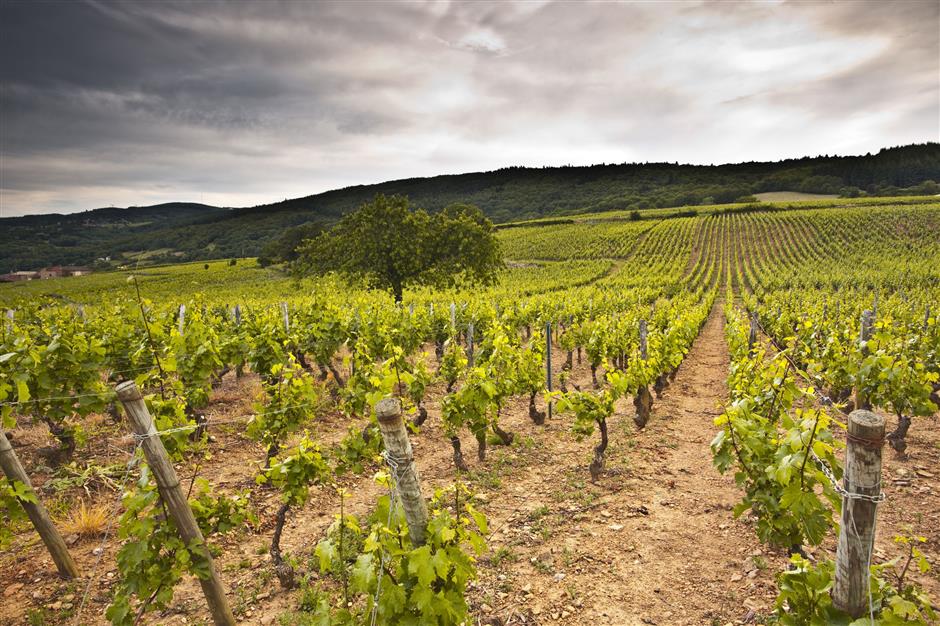Feeling full of beans? Try these summer wines

Macon Chardonnay vineyard
The heat is upon us and this means more dishes with beans, white fungus and bitter gourd. In general, ideal summer wines are light to medium-bodied, crisp, dry and refreshing. Bean dishes in particular beg for a clean and acidic wine to add freshness and emphasize texture.
Let’s look at the humble yet historically important story of the bean. Twenty to thirty thousand years ago on the foothills and steppes of the Himalayas, wild fava or flat beans were foraged by prehistoric tribes. The earliest documented cultivation of beans dates back 9,000 years to Thailand. By the times of the great empires of Egypt, Greece and Rome, the broad bean was well-established as a staple food, especially for the poor who couldn’t afford meat. Beans and peas also played important roles in ancient China.
The hegemony of the broad bean and peas in Western and Asian diets changed after Columbus brought back a variety of New World beans. Soon, green, kidney, lima, black and navy beans captured the fancy of epicureans in Europe and spread to Asia.
Today, a plethora of popular Chinese and Western dishes are based on fresh and dried beans. Delicious by themselves, bean dishes as well as other summer fare are even more scrumptious when accompanied by a synergistic wine. Two of the most bean and summer-friendly styles comes from southern Burgundy.
Macon ACs
Located in Southern Burgundy between Cote Chalonnaise to the north and Beaujolais to the south is the large area of Macon. For many years the wines of Macon existed as the poor and disparaged cousins of the more esteemed Burgundy whites to the north. This was partially due to terroir but also because unscrupulous producers encouraged high yields and used less than ethical winemaking methods to turn out inferior wines. Fortunately, the past 15 to 20 years have seen a marked improvement in quality and white Macons represent some of the best value white wines of Burgundy.
In ascending levels of quality, the appellations of this region are Macon AC, Macon Superieur AC and Macon-Villages AC. Macon also has several villages that make notable wines. The most famous, and expensive, come from Pouilly-Fuisse but the villages of Pouilly-Loche, Pouilly-Vinzelles and Vire-Clesse also often make delicious wines.
When you see the word Superieur on the label it means wines that have at least 11 percent alcohol compared to the 10 percent minimum for Macon AC wines.
There are 43 villages in Macon that are allowed to use Macon-Villages on the label and these wines are generally the most reliable.
Purchasing the right Macon requires a level of selectivity as some producers still make mass production wines that are insipid and dull, but with a modicum of acumen good wines can be found.
Producers to look for include Chanson, Bouchard, Louis Jadot and Lefaire. It’s best to buy only recent vintages, no more than three years old, and serve well-chilled.
Just to the south of Macon is one of the world’s most famous, as well as controversial, red wine regions.
Beaujolais is the largest single district of Burgundy. In most vintages, Beaujolais produces more wine than the Burgundy wine regions of Chablis, Côte d’Or, Côte Chalonnaise and Macon combined. Recently the region became best-known for the phenomenon of Beaujolai Nouveau, but fortunately its story is not limited to these rather unfortunate new wines. Village and cru level Beaujolais offer some of France’s best red wine bargains. Even better are the Cru Beaujolais that are named after villages in the region. These stand at the very top of the Beaujolais quality pyramid and also make elegant companions to Chinese summer dishes.
There are 10 Cru Beaujolais wines. All make good and age-worthy wines but my favorites are Chénas, Juliénas, Morgon and Moulin-a-Vent wines that are the fullest-bodied and most complex of the region. Chénas is the smallest Cru Beaujolais with wines that are noted for their aroma of wild flowers. Good vintages can age well up to 15 years. Juliénas is based around a village named after Julius Caesar and wines from this area are noted for their richness and spiciness.
Morgon is noted for deep colored, earthy wines that can become almost Pinot Noir-like with elegant fruit and silky tannins. Wine from good vintages benefit from at least five years aging and can last for 20.
When choosing a Cru Beaujolais, look for a quality producer.
Top producers available in Shanghai include Louis Jadot, Joseph Drouhin, Thibault Liger and Georges DuBoeuf.
While Cru level Beaujolai wines are serious reds, they should nonetheless be served slightly chilled at about 14-16 degrees Celsius.















